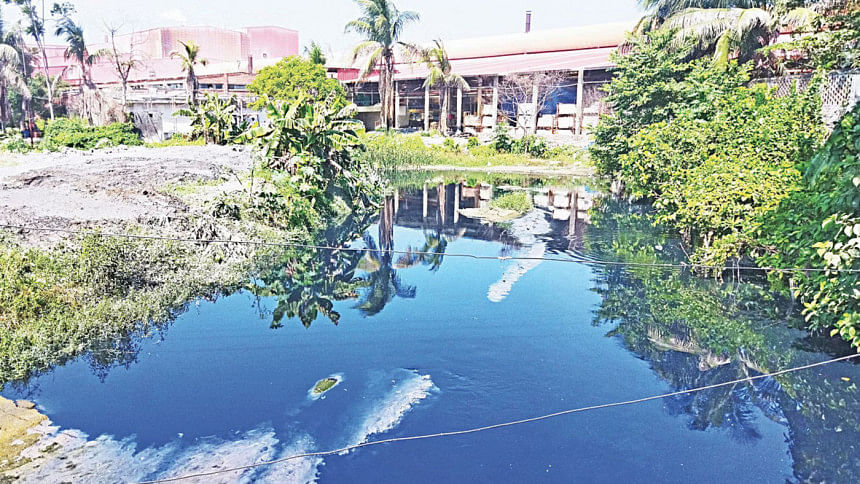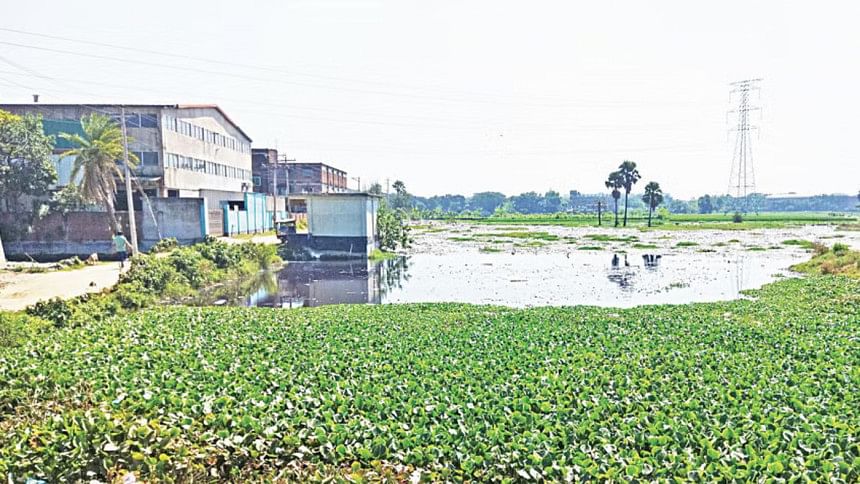Arable land ravaged by industrial pollution in Gazipur

There were very few people on the road. Even the shops and tea stalls were vacant in Gazipur's Dokhola in the afternoon. It seemed life was calm and peaceful for the locals, even though the reality was far from it.
The area lies under Mauna union of Gazipur's Shreepur upazila, the district that has several factories, accused of heavily polluting the environment.
Like the other areas of the district, there are many factories, dyeing and washing plants at Dokhola.
The vast areas of Mauna union's agricultural land have been ravaged due to untreated effluent from many of those factories, said locals.
"Ten years back, our fields were adorned with paddy and different types of vegetables round the year," said 70-year-old Azam Ali of Dokhola village.
"But now we cannot cultivate crops since our fields lost the ability to produce them due to the effluent discharge from factories."

"Almost 1,000 acres of land in our locality lost crop production capacity since the land remains submerged by effluent from the factories," added Azam.
Due to the sheer amount of effluent disposed into the canal from nearby factories, the canal overflows and submerges nearby arable lands.
Talking to this correspondent, Azam informed that the inundation has been occurring in their area ever since the Labalang canal flowing through their locality lost its navigability due to excess waste dumping.
"Let alone our crops, even the tins of our houses don't last for even two years. They get rusted due to chemical-induced air from the factories," said Abdul Jalal of the same area.
While visiting Muktijodhha Nurul Haque Road, around one kilometre from the Mauna intersection on the Dhaka-Mymensingh highway, this correspondent saw several factories on both sides of the road.
Many of the factories have dyeing units and discharged liquid into drains covered with concrete slabs.
Ideally, the effluent was supposed to be treated and cleaned before discharging, but most factories don't obey the rule.
The truth came to light when this correspondent reached the Labalang canal.
A deep brown liquid was coming out from the drains and kept mixing with the canal's dark-coloured water, indicating that it has been polluted for a long time.
"Vast agricultural lands have been ravaged on both sides of the canal, stretching around 50 kilometres from Shreepur upazila to Mirzapur upazila's Bhawal in Tangail," said Khorshed Alam, a member of National River Conservation Committee, Shreepur unit.
"In the early phase of the pollution, factory effluents were being drained out through Labalang canal and straight to Turag River. Once the canal bed had filled up with waste dumped by the municipality and factories, the canal overflowed and the untreated factory liquid spread in the arable land," he said.
"We have been protesting the pollution for eight years with rallies, processions and human chains. However, none of the authorities paid any heed," Khorshed added.
ASM Muaidul Hasan, agriculture officer of Shreepur upazila, said in a rough estimate, around 350 hectares of agricultural land have been reduced in the last 3 to 4 years in the upazila. However, a vast survey is required to determine the exact picture of land loss.
"Not all factories, but dyeing and washing factories are the main polluters in Gazipur," said Nayan Mia, deputy director of the Department of Environment (DoE) in Gazipur.
"There are 542 dyeing and washing factories in the district and almost all of them have effluent treatment plants. The pollution happens when many of them discharge effluents without treating it."
"Monitoring and identifying those factories polluting the environment is tough since there are only six of us from DoE working in the district," he added.
"However, we are conducting raids and placing fines for factories polluting the environment," said the DoE official.

 For all latest news, follow The Daily Star's Google News channel.
For all latest news, follow The Daily Star's Google News channel. 




Comments